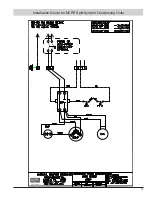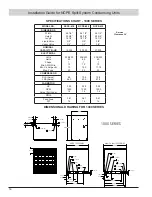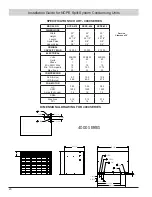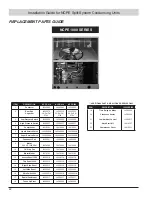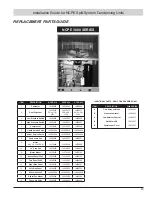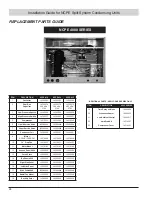
Installation Guide for NCPE Split-System Condensing Units
9
Evacuation
1.
Connect the vacuum pump to the service ports of the liquid
line and the vapor line service valves. If the vacuum pump lines
do not contain shut-off valves, hook up the vacuum pump
through a manifold gauge set, as the vacuum pump lines must
be closed for step 4 below.
a. If the evacuation is being performed on a new system
installation, the condensing unit service valves should be
kept in the closed position. The vacuum pump will then
be able to evacuate the refrigerant lines and evaporator
coil.
b. If the evacuation is being performed on an installation
where the condensing unit factory charge has been lost,
the service valves should be opened.
2.
Following the vacuum pump manufacturer’s instructions,
allow the pump to operate until the system has been evacuated
down to 300 microns.
NOTE: Check for leaks if unable to get to 300 microns.
3.
Allow the pump to continue running an additional 15 minutes.
Turn off the pump and leave connections secured. After 10
minutes if system fails to hold 500 microns or less, check all
connections for tight fit and repeat evacuation procedure.
4.
Isolate the vacuum pump by closing the shut-off valves on
vacuum pump lines or test gauge manifold.
5.
Open the service valves. Opening the service valves will allow
the refrigerant in the condensing unit to enter the refrigerant
lines and evaporator coil. The vacuum pump can now be
disconnected.
Electrical Connections
NOTE:
Make certain that the volts, hertz, and phase correspond
to that specified on the unit rating plate, and that the service
provided by the utility is sufficient to handle the additional load
imposed by this equipment.
Make all electrical connections in accordance with the National
Electrical Code and any pertinent local codes or ordinances.
Use a separate branch electrical circuit for this unit. Locate a
disconnecting means within sight of and readily accessible to
the unit.
a. Line Voltage Connections
b. Connect the single phase power supply to unit contactor
terminal L1 and L2
c. Connect ground wire to lug
d. Low Voltage Connections
Consult the indoor unit installation instructions for thermostat
connections.
Use a 2-wire thermostat cable between the units.
When locating the room thermostat, it should be in the natural
circulating path of room air. Avoid locations where the thermostat
would be exposed to cold air infiltration; drafts from windows,
doors or other openings leading to the outside; exposure to air
currents from warm-or-cold air registers or to exposure where
the natural circulation of the air is cut off, such as behind doors,
above or below mantels, shelves, etc.
Electrical - Low Voltage
Low Voltage Maximum Wire Length
Table defines the maximum total length of low voltage wiring
from the condenser to the indoor unit and to the thermostat.
24 VOLTS
WIRE SIZE
MAX. WIRE
LENGTH
18 AWG
150 Ft.
16 AWG
225 Ft.
14 AWG
300 Ft.
Low Voltage Hook-up Diagram
Contactor
Field Wiring Low Voltage
Yellow
Red
Blue

















